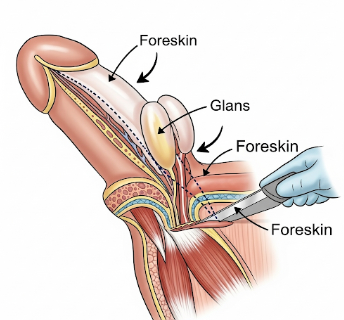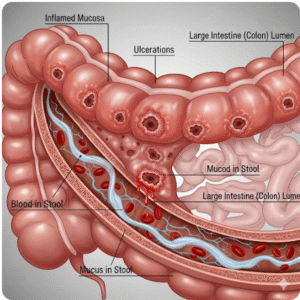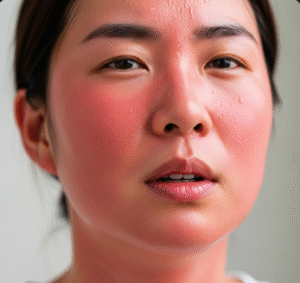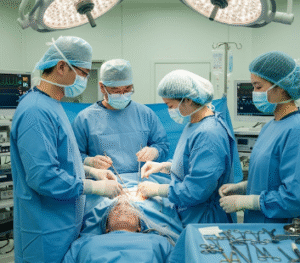Overview
Circumcision in men is a surgical procedure to remove the foreskin of the penis. While often performed in infancy for medical, cultural, or religious reasons, adult men may undergo circumcision for medical indications, personal hygiene, or sexual health concerns.
Importance of adult circumcision:
- Treats medical conditions such as phimosis, balanitis, or recurrent infections.
- Reduces risk of sexually transmitted infections (STIs), including HIV and HPV.
- Improves hygiene and personal care.
- May enhance sexual health or comfort in cases of foreskin-related issues.
In South Korea, adult circumcision is available in urology clinics and hospitals, with modern surgical techniques, anesthesia, and post-operative care to ensure safety and optimal outcomes.
Why It’s Done
Circumcision in adult men is typically performed for medical or functional reasons.
Common indications include:
- ➤ Phimosis: Tight foreskin that cannot be retracted.
- ➤ Paraphimosis: Inability to return retracted foreskin to normal position, causing pain or swelling.
- ➤ Recurrent balanitis: Inflammation or infection of the glans or foreskin.
- ➤ Poor hygiene: Difficulties cleaning under foreskin leading to infections or odor.
- ➤ Sexual discomfort: Pain during intercourse due to tight foreskin.
- ➤ Preventive reasons: Reduction of STI risk in high-risk populations.
Benefits for patients:
- ✔️ Resolves pain, infections, or foreskin-related complications.
- ✔️ Improves hygiene and genital health.
- ✔️ Enhances sexual comfort and function.
- ✔️ Provides long-term preventive benefits against certain infections.
Alternatives
While circumcision is definitive, alternatives exist for mild or early-stage foreskin issues:
- ➤ Topical steroid creams: To loosen a tight foreskin (phimosis).
- ➤ Preputioplasty: Surgical widening of the foreskin without full removal.
- ➤ Careful hygiene and topical antiseptics: May prevent minor infections.
- ➤ Observation: Some minor tightness may improve over time in men without symptoms.
Key point: Adult circumcision is usually recommended when conservative treatments fail or complications arise.
Preparation
Preparation for adult circumcision involves medical assessment, counseling, and surgical planning.
Steps include:
- ✅ Medical history review: Assess bleeding disorders, chronic illnesses, or medications.
- ✅ Physical examination: Evaluate foreskin condition, glans anatomy, and potential complications.
- ✅ Anesthesia planning: Local anesthesia with sedation or general anesthesia depending on preference and complexity.
- ✅ Preoperative counseling: Discuss procedure, expected outcomes, risks, and postoperative care.
- ✅ Fasting: Typically required if sedation or general anesthesia is used.
- ✅ Consent: Signed informed consent after thorough discussion.
Important: Proper preparation ensures safety, comfort, and optimal surgical outcomes.
How It’s Done
Adult circumcision is performed under sterile conditions using modern surgical techniques.
Surgical steps:
- Anesthesia: Local, with or without sedation, or general anesthesia for patient comfort.
- Cleaning and draping: Sterile preparation of the genital area.
- Foreskin removal: Surgical excision using scissors, scalpel, or surgical clamp.
- Hemostasis: Control of bleeding with sutures or cauterization.
- Closure: Suturing of the incision; absorbable stitches often used.
- Dressing: Small protective dressing applied over the surgical site.
- Observation: Short recovery period in clinic or hospital.
Duration: 30–60 minutes
Hospital stay: Outpatient; discharge same day is typical.
Key point: Adult circumcision is safe, precise, and performed with minimal discomfort under proper anesthesia.
Recovery & Postoperative Care
Recovery from adult circumcision is generally smooth with proper care.
Immediate post-procedure:
- Pain and swelling managed with analgesics and ice packs.
- Avoid sexual activity and strenuous exercise for 4–6 weeks.
- Maintain cleanliness and dry dressing as instructed.
Short-term care:
- Sitz baths may help reduce swelling and promote healing.
- Avoid tight clothing to prevent irritation.
- Monitor for bleeding, infection, or unusual discharge.
- Follow-up visits with the surgeon to check wound healing and remove stitches if needed.
Long-term outcomes:
- Complete healing typically occurs within 4–6 weeks.
- Improved hygiene and reduced infection risk.
- Minimal scarring with satisfactory cosmetic and functional results.
Important: Following postoperative instructions reduces complications and ensures optimal recovery.
Possible Complications
Circumcision in adult men is generally safe, but potential complications include:
- ⚠️ Pain, swelling, or bruising in the days following surgery.
- ⚠️ Minor bleeding or hematoma formation.
- ⚠️ Infection – rare with proper hygiene and sterile technique.
- ⚠️ Adhesions or skin bridges – may require minor correction.
- ⚠️ Excessive or insufficient removal of foreskin, sometimes requiring revision.
- ⚠️ Altered sensation – temporary or rarely permanent changes in penile sensitivity.
- ⚠️ Anesthesia-related risks – uncommon in healthy adults.
In South Korea, adult circumcision is performed in licensed urology clinics and hospitals with strict sterile protocols to minimize risks.
Treatment Options / Clinical Relevance in Korea
Adult circumcision is widely available in urology clinics, hospitals, and specialized surgical centers in South Korea.
Key features:
- 🏥 Modern surgical techniques using clamps, scissors, or scalpel for safe foreskin removal.
- 🏥 Pain management with local anesthesia, sedation, or general anesthesia.
- 🏥 Outpatient procedure with short recovery and minimal disruption to daily life.
- 🏥 Postoperative care guidance for optimal healing, hygiene, and infection prevention.
- 🏥 Functional and preventive benefits addressing medical, sexual, and hygiene concerns.
Hospitals and clinics performing adult circumcision in Korea:
- Seoul National University Hospital – Adult urology and circumcision procedures
- Asan Medical Center – Minimally invasive adult circumcision with anesthesia options
- Samsung Medical Center – Outpatient surgical circumcision for men
- Local urology clinics – Accessible and experienced providers nationwide
Highlights in Korea:
- ✔️ Quick, outpatient surgery with effective pain management and rapid recovery.
- ✔️ Strict sterile surgical protocols and experienced surgeons ensure safety.
- ✔️ Reduces risk of infections, phimosis, and sexual discomfort.
- ✔️ Provides medical, preventive, and functional benefits for adult men.
Highlights
- ➤ Circumcision in men removes the foreskin to treat infections, phimosis, or sexual discomfort.
- ➤ Indicated for recurrent infections, tight foreskin, sexual discomfort, or preventive reasons.
- ➤ Alternatives include topical creams, preputioplasty, hygiene measures, or observation.
- ➤ Preparation involves medical review, anesthesia planning, and informed consent.
- ➤ Procedure is outpatient, 30–60 minutes, and performed under anesthesia.
- ➤ Recovery includes pain management, hygiene care, and avoidance of sexual activity for 4–6 weeks.
- ➤ South Korea provides safe, standardized adult circumcision with minimal complications and functional benefits.













